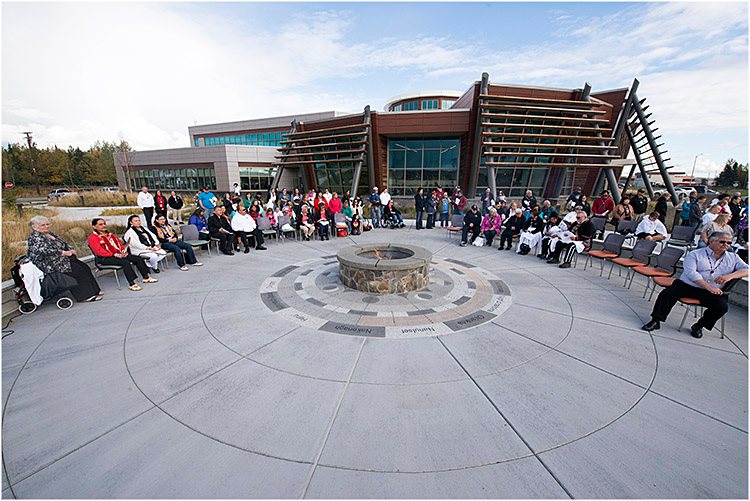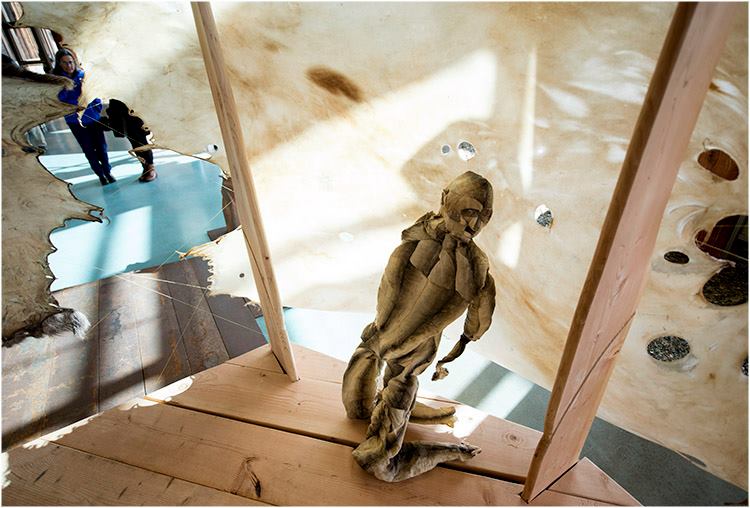
“People forget how important it is to have art living with us. Having those spaces where we can be peaceful and be empowered and heal, that’s what helps keep our community well,” says artist and CIRI shareholder Joel Isaak as he reflects upon the artwork outside of the Kenaitze Indian Tribe’s (KIT) Dena’ina Wellness Center in Kenai, Alaska.
Construction of the Wellness Center itself was completed in 2014, but recently KIT held a dedication for Raven Plaza, a gathering area outside the building conceived and designed by CIRI shareholder Jon Ross. The plaza includes Nak’eljay (“we have the light”), a circular, granite representation of Dena’ina cosmology, a central fire pit and benched seating around the perimeter.
In September, about 200 people assembled for a dedication of the plaza and the opening of Isaak’s exhibit, “Lay Your Burdens Down.” This conceptual art installation features a human form covered in salmon skin and encourages healing and forgiveness in its viewers. Isaak also created the bronze sculptures of a Dena’ina family processing fish, which are also situated on the grounds of the Wellness Center.
“We were very pleased that these pieces we commissioned were created by tribal members,” says CIRI shareholder Jaylene Peterson-Nyren, KIT executive director. “Joel’s piece depicts a family gathering healthy, traditional food in the past, much as we do today. Jon’s piece connects us to the life cycles that have sustained us for generations. Both capture our sense of place here.”
Ross designed the Raven Plaza to tie together Dena’ina history and culture with the land, values and more. “It’s not just for connecting intellectually but also connecting in our hearts—with the land, with the Heavenly Father, with the seasonal cycle, with how and when we do things,” Ross says.
The September dedication connected the plaza and the “Lay Your Burdens Down” exhibit by inviting attendees to write their burdens on a piece of paper, then place them in a birch basket, which was then burned in the ceremonial fire pit at the center of Raven Plaza.

Courtesy of Dena’ina Wellness Center.
While conceptualizing his exhibit, Isaak says, he thought of the ideas he wanted to reflect. In addition to “healing” and “forgiveness,” he sought to emphasize “community”—a key element essential to the actual creation of the exhibit pieces, which include moose hides and fish skins. “Acquiring and scraping so many moose hides myself wasn’t feasible,” Isaak explains. “Some people either gave me hides they had or would tell me where to find them in the woods after a hunt. And the fish skins came from a Kenaitze Elder who wanted to process their fish; I skinned the fish for them and used those skins in the show.”
Both installations use artwork to provide a place where people can feel safe, gather together and share stories.
“People have come up to me and told me about being able to process whatever it was in their life that they needed to let go,” Isaak says, “whether it was about drug or alcohol abuse or sexual assault. Some people have said they’ve just felt an overwhelming sense of peace and comfort coming to the show.”



